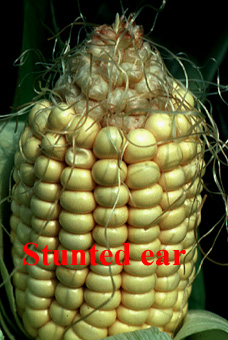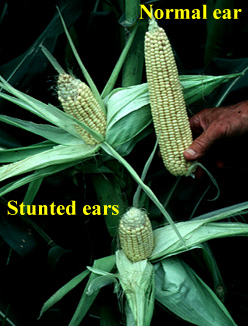 Beer-Can
Ear Syndrome in Corn
Beer-Can
Ear Syndrome in Corn Beer-Can
Ear Syndrome in Corn
Beer-Can
Ear Syndrome in CornA peculiar form of incomplete kernel set has been discovered by growers and seedsmen in parts of Indiana and Ohio in recent weeks, a problem not widely reported in these two states since 1992. The phenomenon has been variously labeled as the Stunted Ear Syndrome, Pinched Ear Syndrome, Beer-Can Ear Syndrome, or Pop-Can Ear Syndrome depending on who is describing the problem.
Symptoms include normal-looking plants and ear shoots (husk leaves), but cob-lengths as short as several inches, varying degrees of kernel set on the short cobs, and a tasselbranch-like appendage on the tip of the cobs. Sometimes instead of a tasselbranch-like appendage on the tip of the cob, one finds the remainder of the tiny ear initial similar to that visible by dissection at about the 9-leaf collar stage.
Kernel row numbers at the base of these ears appear to be normal or at least acceptable. I've seen such ears with 16 to 18 rows of kernels. The problem is, compared to an acceptable 35 to 40 kernels per row, these ears only contain about half that in terms of ovules per row and often only 12 to 16 actual kernels per row.

Few commonalities exist among problem fields regarding soil fertility levels, herbicide programs, or corn diseases; although many of the reported fields were planted during the last two weeks of May. There are definite variety differences within individual fields, but the extent of the problem can also vary dramatically with the same variety planted from one field to another.
The cause of the Beer-Can Ear Syndrome is unknown, but reflects (in my opinion) a single event that arrested early ear shoot development. I believe the problem occurred sometime after the 6-leaf collar stage, when the plants completed development of leaf initials and began development of tassel and ear initials, but not much beyond the 12-leaf collar stage, when potential kernel row numbers were finalized.
Help Us Sort This Out! If you know of a field that exhibits this unusual ear stunting, I would be very interested in learning some of the following details from you. If more than one field or hybrid was affected, please send me information on each circumstance. If you've taken photographs of the problem, send along a few copies.
| Please send the following information to Bob Nielsen, Agronomy Dept., Purdue University, West Lafayette, IN 47907-1150 or by Email to rnielsen@purdue.edu | |
| · State? | · County? |
| · Average length of affected ears? | · Approximate percent of field affected? |
| · Any particular part of the field affected more than others? | · Type of corn (normal yellow dent, white, popcorn, waxy, food-grade)? |
| · Seed company and hybrid number? | · Planting date? |
| · Any major nutrient deficiency problems in affected areas? | · Approximate (or actual) soil pH of affected and unaffected areas? |
| · Post-emergent corn herbicides applied in 1996? (include what and when) | · Post-emergent corn insecticides applied in 1996? (include what and when) |
| · Any unusual weather events during the first 45 days or so after planting? | · The last time you drank a beer in the corn field? (No, no, just kidding!) |
 Return to the the
Chat 'n Chew Cafe.
Return to the the
Chat 'n Chew Cafe.
 The Corn Growers Guidebook , a WWW resource
for corn management systems in Indiana and the eastern CornBelt.
The Corn Growers Guidebook , a WWW resource
for corn management systems in Indiana and the eastern CornBelt.
 Purdue University Agronomy Extension WWW
Home Page.
Purdue University Agronomy Extension WWW
Home Page.
 Purdue Agronomy On-Line! , Purdue's Agronomy
Department WWW Home Page.
Purdue Agronomy On-Line! , Purdue's Agronomy
Department WWW Home Page.